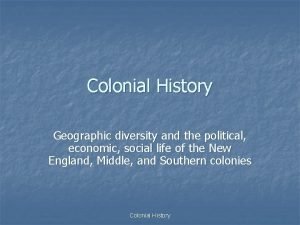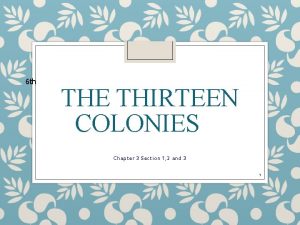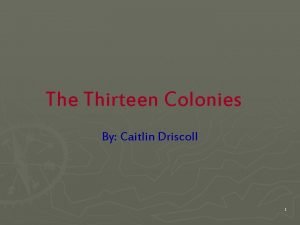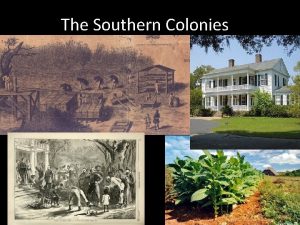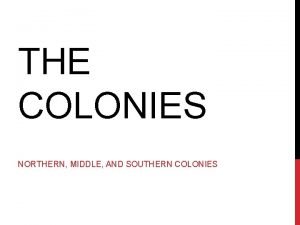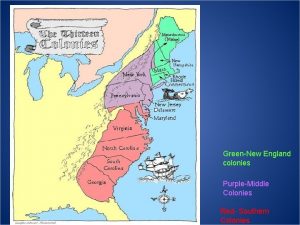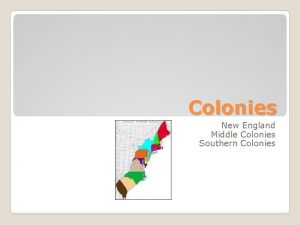GEOGRAPHY OF THE SOUTHERN COLONIES Southern colonies include






- Slides: 6

GEOGRAPHY OF THE SOUTHERN COLONIES Southern colonies include Maryland, Virginia, North Carolina, South Carolina, and Georgia (The Mason –Dixon Line) • Charles Mason and Jeremiah Dixon settle a boundary dispute between Maryland Pennsylvania. • The Boundary line will later separate Free and Slave states. q. The climate was warm and humid. q. Summers were long allowing plantations to grow cash corps like rice tobacco, and cotton The region can be divided onto the Tidewater and Piedmont

VIRGINIA POPULATION GROWTH q. As white populations grew; Native America populations decreased. q. Virginia farmers took more and more Native America lands to grow tobacco. Conflict arose because of this. BACON’S REBELLION q. Poor farmers moved inland search for good farm land. As they did; they came into conflict with Native Americas. q. Virginia's governor refused to help the settlers because he made money from the Indian fur trade. Nathaniel Bacon led a rebellion to force the governor to help, and give the backcountry settle more voice in colonial government. The rebellion ended when Bacon died, but not before they captured burned

MARYLAND AND RELIGIOUS TOLERATION George Calvert set up Maryland as a refuge for English Catholics. His son Cecil Calvert (Lord Baltimore) set up an assembly like the House of Burgesses in Virginia q. Tension between Catholics and Protestants arose. Lord Baltimore help pass the Act of Toleration giving freedom of religion to all Christians in Maryland. q. This did not include Jews, Quakers, and Native Americans

CAROLINA CHARLES II granted a charter(1663) to his friends south of Virginia. His friends named the colony after the king. • The northern part of Carolina developed slowly. • It lacked harbors and rivers for shipping. • People farmed small farms grew tobacco and raised cattle. Some cut lumber for the shipbuilding industry. • The southern part of Carolina grew more quickly. • Plantations produced sugar, rice, and indigo. • Rice became the most important crop. • Plantation owners used slave labor to produce their cash corps. Charlestown became the largest city in the southern colonies. Carolina split into North(1712) and South Carolina(1719)

GEORGIA � REFUGE FOR DEBTORS • LAST OF THE 13 COLONIES (1733) • REASONS FOR FOUNDING: • BUFFER BETWEEN SPANISH FLORIDA AND THE OTHER SOUTHERN COLONIES • REFUGE FOR ENGLISH DEBTORS JAMES OGLETHORPE wanted to protect English debtors and give them a second chance to start a new life. GEORGIA founders wanted a colony of small farms owned by the debtors not large plantations. THEREFORE slavery was at first BANNED. By 1750 the ban against slavery was ended.

Change in the Southern Colonies TWO WAYS OF LIFE TIDEWATER REGION • Dominated by the plantation economy � • MARYLAND, VIRGINIA & NORTH CAROLINA • tobacco chief cash crop • SOUTH CAROLINA AND GEORGIA – • rice was chief cash crop • Plantation Economy created a slave holding society and divided the white community into a small group of wealthy powerful plantation owners and a large group of poor backcountry small farmers THE BACKCOUNTRY- the Piedmont • Isolated by poor roads and long distances

